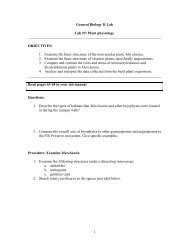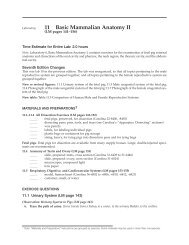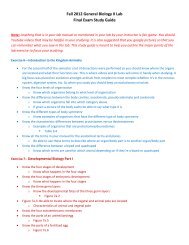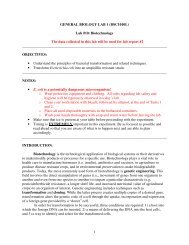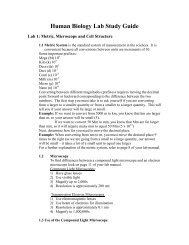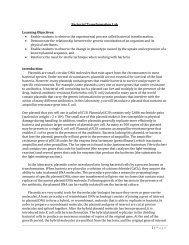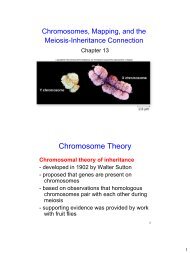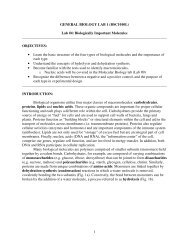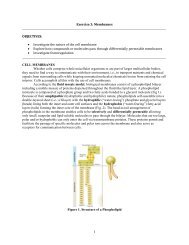Lab #7: Introduction to the Kingdom Animalia Objectives: 1 ...
Lab #7: Introduction to the Kingdom Animalia Objectives: 1 ...
Lab #7: Introduction to the Kingdom Animalia Objectives: 1 ...
Create successful ePaper yourself
Turn your PDF publications into a flip-book with our unique Google optimized e-Paper software.
<strong>Lab</strong> <strong>#7</strong>: <strong>Introduction</strong> <strong>to</strong> <strong>the</strong> <strong>Kingdom</strong> <strong>Animalia</strong><br />
<strong>Objectives</strong>:<br />
1. Understand hierarchical organization of animal complexity<br />
2. Learn <strong>the</strong> differences between acoelomate, pseudocoelomate and coelomate organisms<br />
3. Learn <strong>the</strong> advantages of cellular specialization <strong>to</strong> form tissues and organs<br />
4. Learn how <strong>to</strong> classify organisms by <strong>the</strong>ir type of body symmetry<br />
5. Understand <strong>the</strong> major differences between pro<strong>to</strong>s<strong>to</strong>mes and deuteros<strong>to</strong>mes<br />
6. Learn and employ <strong>the</strong> directional terms used <strong>to</strong> identify body positions on different types<br />
of organisms<br />
Reading Assignments:<br />
• Phylum Porifera (pgs. 387-388)<br />
o Grantia (pg. 388)<br />
o Structure of Sponges (pgs. 389-390)<br />
• Phylum Cnidaria (pgs. 391-392)<br />
o Metridium (pgs. 397-398)<br />
• Phylum Platyhelmin<strong>the</strong>s (pg. 401)<br />
o Dugesia (pg. 402)<br />
• Phylum Nema<strong>to</strong>da (pgs. 407-408)<br />
o Ascaris (pgs. 409-410)<br />
• Phylum Annelida (pg. 420)<br />
o Class Oligochaeta (pgs. 421-422)<br />
• Pro<strong>to</strong>s<strong>to</strong>mes vs. Deuteros<strong>to</strong>mes (pg. 441)<br />
• Phylum Echinodermata (pgs. 441-443)<br />
o Class Asteroidea (pgs. 444-445)<br />
• Phylum Chordata (pg. 449)<br />
• Subphylum Vertebrata (pg. 451)<br />
o Class Osteichthyes (pg. 453)<br />
• Body Terms (pg. 523)<br />
• Body Axes (Fig 47.1 - pg. 524)<br />
<strong>Introduction</strong><br />
The multicellular organisms that make up <strong>the</strong> 32 phyla of <strong>the</strong> kingdom <strong>Animalia</strong> have<br />
evolved from <strong>the</strong> nearly 100 phyla produced during <strong>the</strong> Cambrian explosion about 600 million<br />
years ago. During this time, an unprecedented variety of novel body plans and architectures<br />
arose.<br />
In <strong>the</strong> upcoming labs, we will examine <strong>the</strong> different levels of complexity and<br />
organization in representative phyla of <strong>the</strong> kingdom <strong>Animalia</strong>. We will consider <strong>the</strong>
environmental constraints that led <strong>to</strong> <strong>the</strong> evolution of particular body plans and <strong>the</strong> adaptations<br />
that certain animals evolved <strong>to</strong> survive in <strong>the</strong>ir environment.<br />
In general, organisms from <strong>the</strong> kingdom <strong>Animalia</strong> are eukaryotic, multicellular, motile (at<br />
least during certain developmental stages), heterotrophic and unlike plants, lack a cell wall.<br />
Additionally, most animals reproduce sexually and have a characteristic pattern of embryonic<br />
development. Similar <strong>to</strong> alternation of generations observed in previous phyla, organisms in <strong>the</strong><br />
Animal kingdom undergo stages of development, starting from <strong>the</strong> fusion of an egg and a sperm<br />
and ending with a multicellular adult phase. While <strong>the</strong> morphology of <strong>the</strong> adult organism is<br />
highly species-specific, <strong>the</strong> genes that regulate organismal development are often conserved<br />
across species. In addition, <strong>the</strong> life cycles of members of <strong>Kingdom</strong> <strong>Animalia</strong> vary considerably,<br />
i.e., stages may look completely different from each o<strong>the</strong>r (metamorphorsis), <strong>the</strong>y may last for<br />
different periods of time (hours vs. years) and can occur in different habitats (e.g. dragonflies -<br />
adults live in air while larvae are aquatic).<br />
NOTE: Make sure that you fully understand EVERY term used <strong>to</strong><br />
characterize animals because <strong>the</strong>se terms will appear again in <strong>the</strong> upcoming<br />
labs.<br />
Task 1: Understanding Hierarchical organization of animal complexity<br />
The table below describes <strong>the</strong> major patterns of organization of animal complexity. As you<br />
examine <strong>the</strong> organisms <strong>to</strong>day, note which level of organization is present in <strong>the</strong>se animals.<br />
1. Draw 1 organism per level of organization. The organisms that you should examine are<br />
written in <strong>the</strong> table below. Make sure <strong>to</strong> note <strong>the</strong> Phylum, Genus and Species of <strong>the</strong><br />
organism that you examine.<br />
2. Answer <strong>the</strong> questions below <strong>the</strong> table.
Level of<br />
organization<br />
Pro<strong>to</strong>plasmic Cellular Cell-tissue Tissue-organ Organ-system<br />
Description<br />
Representative<br />
group<br />
All functions<br />
are confined<br />
<strong>to</strong> a cell<br />
Protista<br />
(NOT part of<br />
kingdom<br />
<strong>Animalia</strong>)<br />
We will NOT<br />
look at <strong>the</strong>m<br />
<strong>to</strong>day.<br />
Aggregation<br />
of cells that<br />
are<br />
functionally<br />
differentiated<br />
Cells are<br />
aggregated<br />
in<strong>to</strong><br />
patters/layers<br />
= tissues<br />
Different<br />
tissues are<br />
organized in<strong>to</strong><br />
organs. More<br />
specialized<br />
than tissues.<br />
Organs work<br />
<strong>to</strong>ge<strong>the</strong>r <strong>to</strong><br />
perform a<br />
coordinated<br />
function<br />
Parazoa Radiata Bilateria Bilateria<br />
Example 1<br />
a. Phylum<br />
b. Genus<br />
c. common name<br />
a. Porifera<br />
b. Grantia<br />
c. Sponges<br />
a. Cnidaria<br />
b. Metridium<br />
c. Sea anemone<br />
a.<br />
Platyhelmin<strong>the</strong>s<br />
b. Dugesia<br />
c. Planarian<br />
a. Chordata<br />
b. Perca<br />
c. Perch<br />
Drawing of<br />
whole organism<br />
Slides<br />
CS Grantia
Questions:<br />
1. Can you suggest why, during <strong>the</strong> evolution of separate animal lineages, <strong>the</strong>re has been a<br />
tendency for complexity <strong>to</strong> increase when body size increases<br />
2. Sponges have folded walls. What advantage could this trait have for <strong>the</strong> sponge<br />
3. Could you think of o<strong>the</strong>r organisms or organ systems that also have similar folded structures<br />
a. What advantages does folding provide for <strong>the</strong>se organisms
Task 2: Differences between acoelomate and coelomate organisms<br />
A major developmental event in bilaterally symmetrical organisms (see below) was <strong>the</strong><br />
development of a fluid filled cavity between <strong>the</strong> outer body wall and <strong>the</strong> gut (coelom). The<br />
coelom created a tube-within-tube arrangement allowing space for visceral organs and an<br />
increase in overall body size (Why). The coelom also provides support and aids in movement<br />
and burrowing in some animals. However, not all organisms are coelomates, some lack a coelom<br />
al<strong>to</strong>ge<strong>the</strong>r and are called acoelomate (a = without) while o<strong>the</strong>rs have a pseudocoelom (pseudo =<br />
false). Read page 413 (exercise 38) <strong>to</strong> learn more about <strong>the</strong>se organisms.<br />
Examine <strong>the</strong> animals listed in <strong>the</strong> table below and fill out <strong>the</strong> missing sections.<br />
Sample Organism Acoelomate Pseudocoelomate<br />
Coelomate<br />
(p. 402)<br />
(p. 409)<br />
(p. 421)<br />
Phylum Platyhelmin<strong>the</strong>s Nema<strong>to</strong>da Annelida<br />
Genus Dugesia Ascaris Lumbricus<br />
Common name Flatworms, planaria Roundworms Segmented worms,<br />
Earthworms<br />
Drawing of<br />
Cross section<br />
(slide)<br />
If specimens are<br />
available, dissect<br />
<strong>the</strong>m<br />
longitudinally.<br />
Draw what you see.
Questions:<br />
1. Looking at <strong>the</strong> three representative specimens, what is <strong>the</strong> main difference between<br />
coelomate, pseudocoelomate and acoelomate organisms<br />
2. How are <strong>the</strong> organs and tissues organized differently in coelomates and acoelomates<br />
Task 3: Body plans and symmetry<br />
While <strong>the</strong> diversity of animal forms is great, <strong>the</strong> basic body plans can be categorized by <strong>the</strong><br />
presence and type of body symmetry. Make sure you understand <strong>the</strong> basic differences between<br />
spherical, radial and bilateral symmetry (Examine figure 36.7 on pg 391)<br />
Fill out <strong>the</strong> table below:
Symmetry type Description Example Phyla / Species<br />
Spherical<br />
This symmetry is found in<br />
pro<strong>to</strong>zoa. Any plane passing through<br />
<strong>the</strong> center divides <strong>the</strong> body in<strong>to</strong><br />
equivalent/mirrored halves. Best suited<br />
for floating and rolling.<br />
Radiolaria (amoeboid pro<strong>to</strong>zoa)<br />
WE WILL NOT EXAMINE THIS<br />
TYPE OF SYMMETRY IN THIS<br />
LAB<br />
Asymmetrical<br />
Sponge<br />
Radial<br />
Sea anemone<br />
Bilateral<br />
Perch
Questions:<br />
1. Consider <strong>the</strong> environments where each type of body symmetry would be most efficient.<br />
2. What is <strong>the</strong> advantage of having bilateral symmetry Can any particular task be achieved<br />
more efficiently<br />
a. Why would this type of symmetry lead <strong>to</strong> cephalization
3. Out of all <strong>the</strong> organisms you examined, is <strong>the</strong>re a particular pattern between <strong>the</strong><br />
organisms that have bilateral symmetry Radial symmetry Make sure <strong>to</strong> consider<br />
morphology.<br />
Task 4: Developmental patterns in bilateral animals: Pro<strong>to</strong>s<strong>to</strong>mes and Deuteros<strong>to</strong>mes<br />
Bilateral animals follow two major patterns of embryonic development. Based on <strong>the</strong>se patterns<br />
<strong>the</strong>y are classified as ei<strong>the</strong>r deuteros<strong>to</strong>mes or pro<strong>to</strong>s<strong>to</strong>mes. In deuteros<strong>to</strong>mes, <strong>the</strong> blas<strong>to</strong>pore (first<br />
embryological opening) becomes <strong>the</strong> anus, while in pro<strong>to</strong>s<strong>to</strong>mes <strong>the</strong> blas<strong>to</strong>pore becomes <strong>the</strong><br />
mouth. Also, cleavage, <strong>the</strong> initial process of cell development after a zygote is formed is<br />
different in <strong>the</strong> two lineages: In pro<strong>to</strong>s<strong>to</strong>mes, cleavage is spiral, while it is radial in<br />
deuteros<strong>to</strong>mes.<br />
The separation of <strong>the</strong> metazoans (multicellular animals) in<strong>to</strong> two separate lineages, suggests an<br />
evolutionary divergence of <strong>the</strong> bilateral body plan. This suggests that deuteros<strong>to</strong>mes and<br />
pro<strong>to</strong>s<strong>to</strong>mes are separate, monophyletic lineages. For fur<strong>the</strong>r information, please look at table<br />
40.1 (pg. 441) in your lab manual.<br />
Examine <strong>the</strong> animals noted under <strong>the</strong> “Example species” below and answer <strong>the</strong> questions below<br />
<strong>the</strong> table.
Pro<strong>to</strong>s<strong>to</strong>mes<br />
(mouth first)<br />
Deuteros<strong>to</strong>mes<br />
(mouth second)<br />
Cleavage type Spiral Radial<br />
Blas<strong>to</strong>pore<br />
Mouth<br />
Anus<br />
becomes<br />
Representative<br />
Phyla<br />
Platyhelmin<strong>the</strong>s, Arthropoda,<br />
Annelida, Mollusca, Nema<strong>to</strong>da, and<br />
smaller phyla<br />
Chordata, Echinodermata, and<br />
smaller phyla<br />
Example species Nema<strong>to</strong>da - Ascaris Sea star – Asterias<br />
Drawing<br />
Task 5: Describing positions in bilaterally symmetrical animals<br />
For a large portion of this course we will be examining bilaterally symmetrical animals from<br />
various phyla. To be able <strong>to</strong> locate and refer <strong>to</strong> specific regions of animal bodies, we will use<br />
terminology in your lab manual (pg. 523).<br />
Practice with your group using directional terms <strong>to</strong> refer <strong>to</strong> a particular part/portion of <strong>the</strong> body.<br />
You may use available specimens <strong>to</strong> practice. Make sure <strong>to</strong> use both radially and bilaterally<br />
symmetrical animals.<br />
The table below compares <strong>the</strong> terms used <strong>to</strong> describe animals with bilateral and radial<br />
symmetries.
Radially-Symmetrical and Bilaterally-Symmetrical Animals<br />
Bilateral<br />
Radial<br />
Direction Synonyms Direction Synonyms<br />
Anterior<br />
Rostral, Cranial,<br />
Cephalic<br />
Oral<br />
Apical<br />
Posterior Caudal Aboral Basal<br />
Dorsal — Peripheral —<br />
Ventral — Peripheral —<br />
Left (lateral) Sinister Peripheral —<br />
Right (lateral) Dexter Peripheral —<br />
Medial — Same —<br />
Proximal — Same —<br />
Distal — Same —<br />
Adapted from Wikipedia.<br />
Task 6: Body axes charades – Run by <strong>the</strong> TA<br />
To practice using <strong>the</strong> proper terminology <strong>to</strong> refer <strong>to</strong> different locations on <strong>the</strong> body, we<br />
will play a game of charades. Your TA will divide <strong>the</strong> whole class in<strong>to</strong> two groups. Each group<br />
will be given a list of organs/ body parts. These lists will be different. Make sure not <strong>to</strong> share<br />
your list with members from <strong>the</strong> o<strong>the</strong>r group.<br />
Your group will choose a student from ano<strong>the</strong>r group <strong>to</strong> describe one of <strong>the</strong> words on<br />
your list <strong>to</strong> his/her group. The student will have 2 minutes <strong>to</strong> describe <strong>the</strong> word, using only <strong>the</strong><br />
words from <strong>the</strong> bilateral body axes (see table above). You cannot use words that describe <strong>the</strong><br />
function of <strong>the</strong> organs. For example, if <strong>the</strong> organ <strong>to</strong> be described is <strong>the</strong> heart, <strong>the</strong>n you cannot say<br />
that it pumps blood, but you can say that this organ is posterior <strong>to</strong> <strong>the</strong> head. If his/her group can<br />
guess <strong>the</strong> right organ /body part, his/her team gets a point but if <strong>the</strong>y don’t guess correctly, <strong>the</strong>n<br />
your team gets <strong>the</strong> point. Make sure <strong>to</strong> alternate <strong>the</strong> order of <strong>the</strong> teams guessing.



